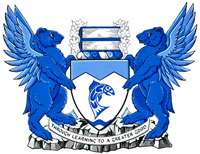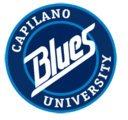Capilano University
 | |
| Type | Public |
|---|---|
| Established | 1968[1] |
| President | Paul Dangerfield[2] |
| Undergraduates | 11,000[3] |
| Location |
|
| Campus | Suburb |
| Colours |
Blue White |
| Athletics |
 |
| Nickname | Capilano Blues |
| Mascot | Blues |
| Affiliations | ACCC, NWCCU, CBIE, CUP |
| Website | capilanou.ca |
|
| |
Capilano University is a teaching-focused university based in North Vancouver, British Columbia, Canada, with programming serving the Sunshine Coast and the Sea-to-Sky corridor. Capilano University is enabled by the University Act,[4] enrolling its first students in 1968. The school was established by local school boards and residents of the North Shore and Howe Sound on the need for a public institution serving the local communities. Initial enrollment was 784 students in 1968,[1] and as of 2016, has grown to enroll approximately 11,600 students per year.[3] Under the direction of its then president, Greg Lee, Capilano University was re-designated from a community college to a university, in 2008.[5] Capilano University's academic offerings include liberal arts, professional and career programs, leading to certificates, diplomas and degrees at the primarily undergraduate level.
Capilano University's sports teams are nicknamed the Blues, and periwinkle blue is the official school colour. The Blues have won numerous national titles in the Canadian Colleges Athletic Association, and even more provincial titles in the British Columbia Colleges Athletic Association.[6]
History
Founding
The school boards of North and West Vancouver, Howe Sound and Sechelt formed a committee to determine the need for a community college to serve the North Shore. The proposal to build a college on the North Shore passed by a plebiscite in North and West Vancouver and the Howe Sound in 1967. However, the motion was defeated in Sechelt. The provincial government granted approval and Capilano College got its name selected from submissions made by North Shore residents. Capilano opened on September 10, 1968 with 784 students attending classes after hours at West Vancouver Secondary. The Capilano College Foundation was created in 1970 to provide scholarships and bursaries for students.[7]
In 1970, construction began on the North Vancouver campus in the Lynnmour area. Three years later, the permanent North Vancouver campus opened with 1,965 students in attendance. The first vocational programs were offered in portable buildings brought from West Vancouver Secondary. The first permanent structure at the North Vancouver campus, the original library building, also opened. In 1976, the Arbutus building at the North Vancouver campus opened, and the Fir building at the North Vancouver campus opened in 1982. In 1991, the Cedar building, the Sportsplex, and Horticulture building were completed. Two years later, a new library replaced the former at the North Vancouver campus, tripling the size of existing library space. In 1996, The Birch building at the North Vancouver campus is completed, housing a performance theatre, classrooms, student services, and providing teaching space. The Child Care Centre also opened in the same year.[7]
Expansion
Capilano offered its first bachelor degree, a collaborative degree in music therapy with the B.C. Open University in 1990. A second music degree in jazz studies was offered by 1992.[8] Business administration was offered in 1993. That year, Capilano also conferred its first associate degrees. Tourism management was added to degree offerings in 1997. The college was authorized by the provincial government in 2003 to become the first college in British Columbia to independently grant applied degrees after the dissolution of the B.C. Open University. Capilano was also named by the provincial government as host of the British Columbia Centre for Tourism Leadership and Innovation in 2004, in preparations for the 2010 Winter Olympics. In 2008, Capilano became a candidate for accreditation with the Northwest Commission on Colleges and Universities, joined the OpenCourseWare consortium, and was redesignated as a university.[7]
Campuses
Capilano University's main campus is at 2055 Purcell Way in the District of North Vancouver, on Metro Vancouver's North Shore. It is approximately a 20-minute drive from Downtown Vancouver. The majority of the programs are offered at this campus.
Capilano University serves campuses located on the traditional and ancestral territory of the Squamish, Tsleil-Waututh, Musqueam, Lil’wat and Sechelt (shíshálh) Nations.
Academics
Profile
Capilano University offers more than 100 programs, including 12 bachelor’s degrees, in areas as diverse as film and animation, early childhood education and tourism management. Interdisciplinary programs unique to Capilano University include the global stewardship program,[9] and British Columbia studies.[10] Capilano also offers niche programs with an applied focus, such as Applied Behaviour Analysis - Autism, applied ethics,[11] illustration/design (IDEA),[12] and music therapy.[13] The Capilano School of Motion Picture Arts offers motion picture technical skills training awarding various certificates and diplomas including an applied Bachelor of Motion Picture Arts degree.
Capilano University offers joint partnerships and projects as part of the school's commitment to international education.[1] It has dual degree programs and development partnerships with various schools abroad.[14]
2010 Winter Olympics
In 2004, the Province of British Columbia established the British Columbia Centre for Leadership and Innovation in Tourism at Capilano University.[15] This establishment came as part of the efforts by the provincial government to capitalize on the Vancouver 2010 Winter Olympics. The centre addresses tourism issues, helps provide tourism education, and is part of the larger British Columbia Tourism and Hospitality Education and Training Consortium.[16] In 2008, the centre was merged into Link BC, an education network for tourism and hospitality with industry organizations.[17] This has resulted in partnerships with organizations and opportunities for students.[18]
Scholarships and bursaries
The Government of Canada sponsors an Aboriginal Bursaries Search Tool that lists more than 680 scholarships, bursaries and other incentives offered by governments, universities and industry to support Aboriginal post-secondary participation. Capilano University scholarships for Aboriginal, First Nations and Métis students include: Bank of Montreal Award for Business Leadership; Irene June Wealick Memorial Award; HSBC Bank Canada Aboriginal Bursary; BC Aboriginal Student Award.[19]
Campus life
Athletics
Capilano has eight varsity sport teams that play at the provincial and national levels. The official intercollegiate representing team is the Capilano University Blues. The Blues are based in Capilano University's North Vancouver campus and have their home court in the Sportsplex Building. Capilano University competes at the intercollegiate level in badminton, basketball, golf, soccer, and volleyball.[20]
Between 1974 and 1999, the Capilano Blues held the title for CCAA Soccer Supremacy Award.[6] In 2008 the Blues won the national championship in soccer.[21][22]
Press
- Until 2014, the University supported The Capilano Review, a journal which highlights experimental poetry, fiction, drama, and visual art. After funding was cut, the magazine relocated to downtown Vancouver.
- Until 2013, the University also supported Capilano University Editions (CUE), founded in 2008. A book publishing imprint of the Capilano Press Society focusing on Canadian avant garde writing and art, it now operates independently from the University.
- The main student newspaper of the college is The Capilano Courier. The Courier, which operates independently of the college and the student society, is staffed by students. It is published weekly.
- Capilano University's creative writing students publish an innovative literary magazine, The Liar, in the spring and fall terms, with funding from the English department.
Student organizations
Every student enrolled in a credit program at Capilano University are members of the Capilano Students' Union (CSU). The CSU is the resident student society of Capilano University and benefits the university and the community by advancing the interests of students. Like other British Columbian student societies, the CSU has the mandate generally to advocate for students and to provide services and events that improve the student experience. While the day-to-day management and operations is entrusted to a board of directors composed of elected students, governed by the constitution and bylaws of the society, students are ultimately in control the activities of the CSU. The board of directors consists of six constituency representatives, four issues coordinators and the student representatives elected to the senate and board of governors. The CSU is registered under the Society Act of B.C. and receives funding from membership fees, collected from students by the University in accordance with the University Act.
The CSU provides some services to its members, including a low-cost transit pass, free day-planner and a used book sale. More recently, a referendum was held in 2011 to approve the fee required for the student society to provide a supplemental health and dental insurance plan and was approved with the support of 97% of voters. Student interests are represented by the CSU, and the views of students are presented and advocated for in meetings with university administrators and representatives of local, provincial and federal governments. The student society also promotes the development of the campus community and improves the student experience by hosting events and through supporting the development of student clubs and associations.
See also
References
- 1 2 3 "About Capilano University". Capilano University. Retrieved 2009-01-14.
- ↑ https://www.capilanou.ca/about/president-office/. Retrieved 2014-05-22. Missing or empty
|title=(help) - 1 2 "Student Enrollment Statistics". Capilano University. Retrieved 2010-08-04.
- ↑ "''University Act''". Qp.gov.bc.ca. Retrieved November 28, 2011.
- ↑ "First Chancellor for New Capilano University". Ministry of Advanced Education and Labour Market Development. Retrieved 2009-01-18.
- 1 2 "Blues History". Capilano University. Retrieved 2009-04-10.
- 1 2 3 "Pivotal moments at Capilano". Capilano University. Retrieved 2009-01-18.
- ↑ Patricia Rolston, Susan Spier. "Music at Community Colleges". The Encyclopedia of Music in Canada. Thecanadianencyclopedia.com. Retrieved November 28, 2011.
- ↑ "Global Stewardship News & Events". Capilanou.ca. Retrieved November 28, 2011.
- ↑ "BC Studies". Capilanou.ca. February 22, 2011. Retrieved November 28, 2011.
- ↑ "Specialization in Applied Ethics". Capilanou.ca. July 17, 2008. Retrieved November 28, 2011.
- ↑ "IDEA". Capilanou.ca. Retrieved November 28, 2011.
- ↑ "About Music Therapy". Capilanou.ca. Retrieved November 28, 2011.
- ↑ "International Partnerships & Projects". Capilano University. Archived from the original on March 16, 2010. Retrieved 2009-04-08.
- ↑ "Tourism, Hospitality Centres to Help Prepare for 2010". Ministry of Advanced Education and Labour Market Development. Retrieved 2009-01-18.
- ↑ "Tourism & Hospitality Education and Training Consortium". Ministry of Advanced Education and Labour Market Development. Retrieved 2009-01-18.
- ↑ "Who We Are". Link BC. Retrieved 2009-01-18.
- ↑ "MOU benefits Capilano's tourism students and Tourism Vancouver in 2010". Capilano University. Retrieved 2009-01-18.
- ↑ Aboriginal Bursaries Search Tool
- ↑ 2008–09 Blues Teams Archived March 9, 2009, at the Wayback Machine.
- ↑
- ↑
External links
| Wikimedia Commons has media related to Capilano University. |
- Official website
- Capilano Students' Union
- The Capilano Review
- CUE: Capilano University Editions
- https://www.capilanou.ca/smpa/
- http://www2.news.gov.bc.ca/news_releases_2009-2013/2012AVED0007-000164.htm
Coordinates: 49°19′07″N 123°01′10″W / 49.31861°N 123.01944°W